When we state a fact, we like to provide the footnotes. Below are minute-by-minute references for journalists and others who wish to explore the topics of Planet of the Humans more closely. This page may be updated from time to time to provide additional clarity as questions arise (also see our FAQs).
Click on the timecode to jump to scene
00:03:25
“Our atmosphere seems to be getting warmer! This is bad?” …That was 1958.
The Unchained Goddess – co-written & produced by Frank Capra was originally broadcast in 1958 and subsequently shown in classrooms across the United States. Even then the idea of ‘climate change’ wasn’t new.
00:04:19
Back then there was so much air pollution it would actually block out the sun.
Remembering a City Where the Smog Could Kill: “Once upon a time, you could touch the air in New York…”
The New York Times
Photos: L.A.’s mid-century smog was so bad, people thought it was a gas attack:
Timeline
00:04:26
There was so much water pollution rivers caught on fire. Forget throwing plastic bottles into the water – we tossed our cars in there.
The Shocking River Fire That Fueled the Creation of the EPA:
History
The Cuyahoga River caught fire 50 years ago. These stomach-churning photos highlight why the EPA exists:
Business Insider
00:04:39
We also knew someday we’d run out of oil.
Mass panic over oil struck twice in the 1970s. First as a result of the OPEC oil embargo of 1973, then again in 1979 when oil output decreased following the Iranian Revolution.
00:04:56
A scientist sounded the alarm and the modern environmental movement was born.
Rachel Carson, biologist, writer, ecologist (1907 – 1964)
“Humankind is challenged, as it has never been challenged before, to prove it’s maturity and its mastery – not of nature, but of itself.” ~1962
00:05:06
Students all across the country organized the first Earth Day.
April 22nd, 1970 Earth Day was born.
The History Of Earth Day:
EarthDay.org
The ‘Profoundly Radical’ Message of Earth Day’s First Organizer:
The New York Times
00:09:40
Al Gore helped convince billionaire airline owner Sir Richard Branson to invest in green energy.
Branson pledges $3bn transport profits to fight global warming:
The Guardian
00:10:32
Robert F. Kennedy Junior was both on the board of major environmental organizations and was leading a green energy investment group.
Kennedy served as venture partner at VantagePoint Capital Partners, one of the world’s largest clean tech capital firms. VantagePoint was also the biggest pre-IPO investor in Tesla.
Crunchbase
00:10:47
The Sierra Club got $50M from Michael Bloomberg to help fight coal and promote clean energy.
Bloomberg Philanthropies Commits $50 Million to Sierra Club’s Beyond Coal Campaign to Move America Toward Cleaner Energy:
Bloomberg Philanthropies
00:15:07
“The efficiency of these panels is only about, just under, eight percent.”
Eight-percent happened to be the efficiency of the solar panels we visited early in our exploration. This scene occurs in the past following the Obama administration’s roll-out of green stimulus funds, and the film does not imply that all solar panels are 8% efficient. However, this is the same efficiency as Tesla’s new solar shingles. In the end, more efficient panels are shorter lived or more expensive, resulting in about the same output per dollar spent across the board. Whether the panels had been 8%, 20% or even 30% efficient does not rise to the level of being relevant to the overarching analysis of the film. In any case, this efficiency rating isn’t the best way to understand how a solar cell operates in the real-world due to cloud cover, sun angle, dust, haze, rain, hail, heat, and nighttime. In Michigan, solar cells produce approximately 13% of their rated capacity over a year, regardless of their efficiency.
“Old Data” Is a Lie: “Planet of the Humans is a story — a nonfiction story. Stories take place over time. Stories reveal higher truths than data alone—like what questions we are even supposed to be asking. To say a documentary has ‘old footage,’ as if that’s taboo, either means this person doesn’t watch many documentaries, or they are trying to create a red herring and get the reader to believe they should be upset about something — anything! That said, our data is up to date, and everything you see in the film is accurate. The data in Planet of the Humans, in charts, graphs and interviews with experts and activists, runs all the way to the present — up to and including 2019 and 2020.”
Planet of the Humans Article
What’s the efficiency of a Tesla glass tile solar roof?: “It depends. We attempt to do the math. Maybe it doesn’t matter.”
PV Magazine
Solar explained, Photovoltaics and electricity:
U.S. Energy Information Administration (EIA)
Performance evaluation of large solar photovoltaic power plants in Spain: “This work presents a comprehensive study of the performance of six large photovoltaic (PV) power plants with different mounting topologies over several years of operation. This is a marked contrast to most available performance studies which focus on the study of a single installation of low rated power and one mounting type. The performance results are obtained following the guidelines of Standard IEC 61724 and largely coincide with those expected considering the plants’ location in the South-Central Region of Spain, with a total system efficiency ranging between 10% and 12%.”
Science Direct
00:17:43
Vermont Wind Guide: Vermont removed mountain top areas to build 21 wind turbines.
The Not-So-Green Mountains:
The New York Times
00:18:16
“How long are these towers supposed to last?” “20… 20-something years…”
Wind turbine blades can’t be recycled so they’re piling up in landfills:
Bloomberg

Photographer: Benjamin Rasmussen
00:18:48
“You’ve got to have a fossil fuel power plant backing it up and idling 100% of the time… Let’s say the wind stopped right now, just stopped for an hour… you’ve got to have that power.”
Have fossil fuels been substituted by renewables? An empirical assessment for 10 European countries: The installed capacity of wind power preserves fossil fuel dependency.
Science Direct
The $2.5 trillion reason we can’t rely on batteries to clean up the grid: “Fluctuating solar and wind power require lots of energy storage, and lithium-ion batteries seem like the obvious choice—but they are far too expensive to play a major role.”
MIT Technology Review
Don’t Call Me a Pessimist on Climate Change. I Am a Realist (see also links within):
The Tyee
00:22:38
Richard York of Oregon State University published a study in the journal Nature in which he posed the question: do non-fossil energy sources actually replace fossil fuels?
Energy transitions or additions? Why a transition from fossil fuels requires more than the growth of renewable energy: “Previous changes in the proportion of energy produced by various sources – such as in the nineteenth century when coal surpassed biomass in providing the largest share of the global energy supply and in the twentieth century when petroleum overtook coal – could more accurately be characterized as energy additions rather than transitions. In both cases, the use of the older energy source continued to grow, despite rapid growth in the new source. Evidence from contemporary trends in energy production likewise suggest that as renewable energy sources compose a larger share of overall energy production, they are not replacing fossil fuels but are rather expanding the overall amount of energy that is produced. We argue that although it is reasonable to expect that renewables will come to provide a growing share of the global energy supply, it is misleading to characterize this growth in renewable energy as a ‘transition’ and that doing so could inhibit the implementation of meaningful policies aimed at reducing fossil fuel use.”
Elsevier: Energy Research & Social Science
Do alternative energy sources displace fossil fuels?: “These results challenge conventional thinking in that they indicate that suppressing the use of fossil fuel will require changes other than simply technical ones such as expanding non-fossil-fuel energy production.”
Nature: International Weekly Journal Of Science
00:24:41
Ozzie: “They don’t use sand (for solar) – So this is one of the ingredients. It’s actually mined quartz…You can’t just use sand. Sand has too many impurities. So you start with very high quality quartz and a very high quality coal and then you put those two together into an arc furnace and you melt them.”
Why do we burn coal and trees to make solar panels?:
Research Gate
The Ultra-Pure, Super-Secret Sand That Makes Your Phone Possible, The processor that makes your laptop or cell phone work was fabricated using quartz from this obscure Appalachian backwater:
Wired
Solar Energy Isn’t Always as Green as You Think:
IEEE Spectrum
00:25:53
Ozzie Zehner said it was an illusion that renewables were replacing coal or any fossil fuel.
Don’t Call Me a Pessimist on Climate Change. I Am a Realist: As long as the growth in demand exceeds additions to supply from renewables, the latter cannot displace fossil fuels even in electricity generation — and remember, electricity is still less than 20 per cent of total energy consumption, with the rest being supplied mostly by fossil fuels.
The Tyee
Ozzie Zehner: “Green Illusions” | Talks at Google:
YouTube
Energy transitions or additions? Why a transition from fossil fuels requires more than the growth of renewable energy: “Previous changes in the proportion of energy produced by various sources – such as in the nineteenth century when coal surpassed biomass in providing the largest share of the global energy supply and in the twentieth century when petroleum overtook coal – could more accurately be characterized as energy additions rather than transitions. In both cases, the use of the older energy source continued to grow, despite rapid growth in the new source. Evidence from contemporary trends in energy production likewise suggest that as renewable energy sources compose a larger share of overall energy production, they are not replacing fossil fuels but are rather expanding the overall amount of energy that is produced. We argue that although it is reasonable to expect that renewables will come to provide a growing share of the global energy supply, it is misleading to characterize this growth in renewable energy as a ‘transition’ and that doing so could inhibit the implementation of meaningful policies aimed at reducing fossil fuel use.”
Elsevier: Energy Research & Social Science
The Limits of Clean Energy: If the world isn’t careful, renewable energy could become as destructive as fossil fuels.
Foreign Policy
00:26:23
Ozzie: “They are actually replacing it with two natural plants and of course natural gas is a fossil fuel…This is the Las Vegas natural gas co-gen plant, this is one of the facility that’s replacing the coal plant that’s being shut down. This is the Sun Peak Generating Facility. This is the second natural gas plant that’s being used to replace the coal plant.”
Las Vegas Review Journal: “NV Energy may close three of its four Reid Gardner coal-fired units generating electricity in Southern Nevada by the end of this year, according to documents filed Thursday with the Public Utilities Commission…The capacity will be replaced with the purchase of two existing gas-generated plants…”
Las Vegas Review-Journal
Note, the utility also added a 200MW solar array highlighted by protesters in the film, which due to the intermittent nature of solar, cannot replace a coal plant directly. The capacity factor of solar in Iowa is under 30%, so actual annual output would be under 60MW of intermittent energy. (U.S. Energy Information Administration)
00:26:45
Ozzie: “They’re doing the same thing in Iowa… but then they’re building a larger natural gas. This is a 650 megawatt natural gas plant… that’s four times larger than the coal burning plant— over there.”
Original Sutherland Generating Station 3001 East Main St., Marshalltown, IA 50158 was a 157MW coal plant:
Oak Ridge National Laboratory
The plant was replaced by the 650MW natural gas facility filmed next door:
Alliant Energy
It was a central “fight” of the Sierra Club – 200th coal plant closed:
Sierra Club
00:27:08
Ozzie: “And they’re doing the same thing in North Carolina which was the subject of that Years of Living Dangerously uh series … But what they don’t tell you is that we’re also building a larger natural gas facility.”
Duke Energy to retire Asheville coal plant:
Mountain Xpress
00:27:54
Ozzie: “In fact the Sierra Club’s “Beyond Coal” actually coincides with one of the largest expansions of fossil fuel production that we’ve ever pulled off.”
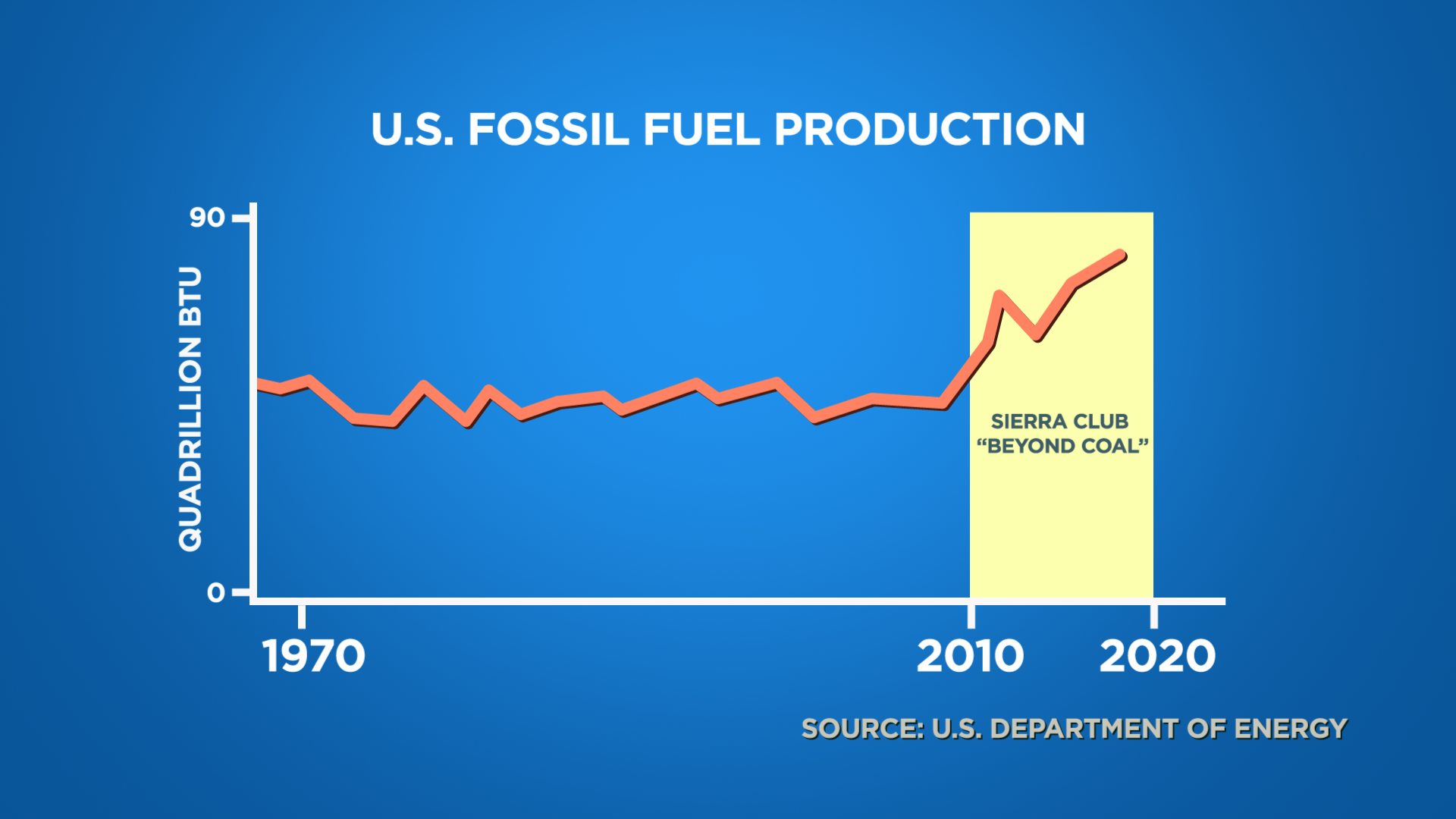
Source: U.S. Department of Energy, Energy Information Administration, Total Fossil Fuel Primary Energy Production, accessed March 2020.
00:28:40
Intermittency
The Sun Doesn’t Always Shine, the Wind Doesn’t Always Blow — and the Fact Is, Intermittency Has Not Been Solved: “People whose whole work is built around promoting (and sometimes benefiting from) the eco-industrial complex have perhaps lost their way or are too afraid to tell you the truth.”
Planet of the Humans Article
“Old Data” Is a Lie: “Planet of the Humans is a story — a nonfiction story. Stories take place over time. Stories reveal higher truths than data alone—like what questions we are even supposed to be asking. To say a documentary has ‘old footage,’ as if that’s taboo, either means this person doesn’t watch many documentaries, or they are trying to create a red herring and get the reader to believe they should be upset about something — anything! That said, our data is up to date, and everything you see in the film is accurate. The data in Planet of the Humans, in charts, graphs and interviews with experts and activists, runs all the way to the present — up to and including 2019 and 2020.”
Planet of the Humans Article
According to a prominent proponent of renewable energy, The National Renewable Energy Laboratory, electrical grids will encounter disruption and higher integration costs if variable solar and wind technologies were ever to reach 30 percent penetration.
National Renewable Energy Laboratory
Dr. James Hansen on Intermittency: “The people who argue for all renewables think that, well, if we can go from 0% to 10% to 20% renewable then we’re on the way and then it will get easier and we’ll get to 100% …if you look at the engineering, it’s actually the opposite. When you to 20 or 30%, then it gets harder! Not easier! …because of the intermittency of the renewables.” (YouTube)
The Paradox of Declining Renewable Costs and Rising Electricity Prices:
If the cost of renewable power generation is falling, how can their use cause retail prices to rise?
Forbes
00:30:37 “Global Annual Energy Use vs. Battery Capacity” graphic
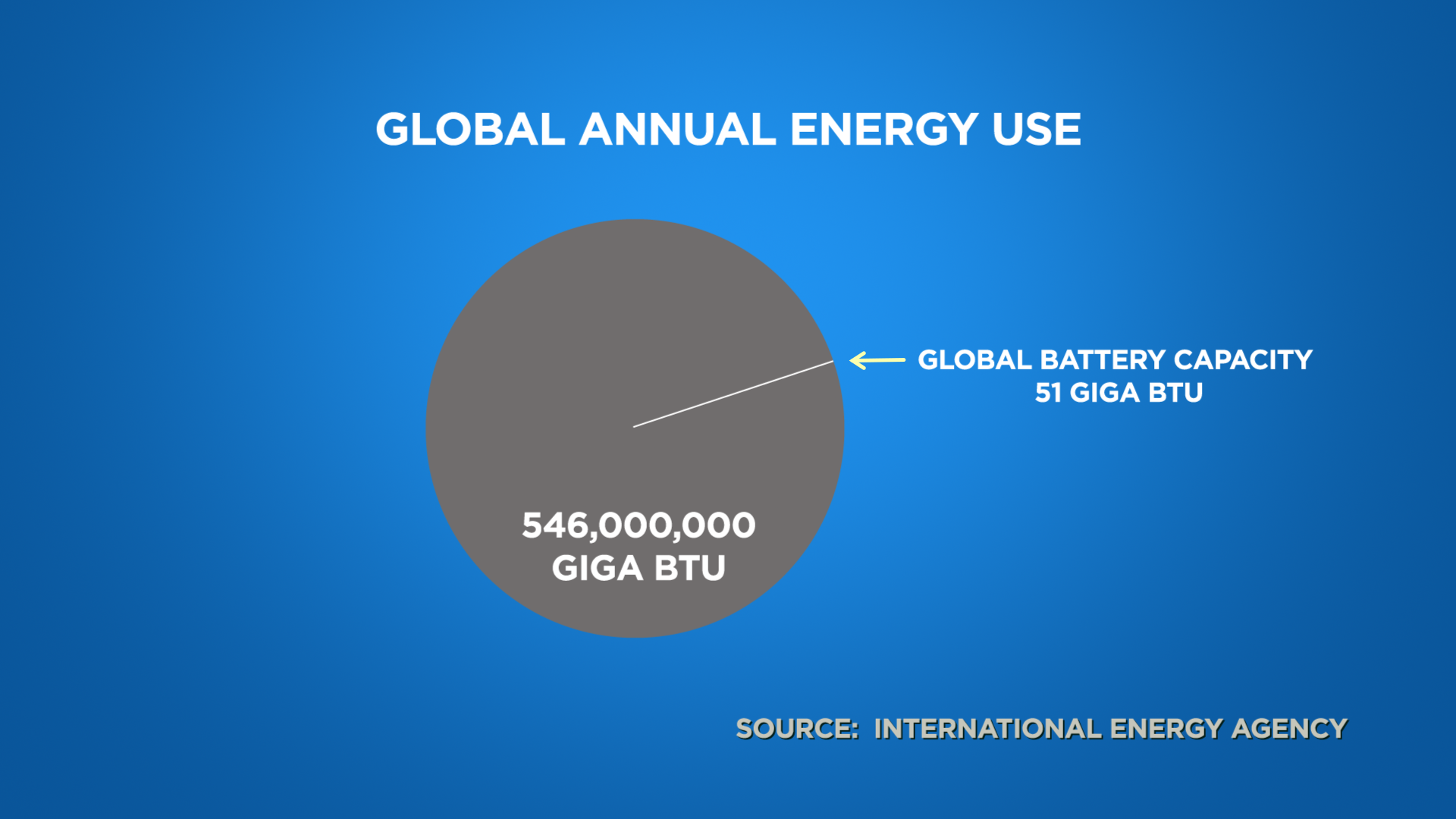
Source Data:
Global Energy Use: 576,000,000 TJ
Global Battery Capacity: 54 TJ
(note: unit conversion applied)
Source: International Energy Agency, Tracking Energy Integration accessed March, 2020 (International Energy Agency) & U.S. Department of Energy, Energy Information Administration, Primary Energy (Global), accessed March 2020.
The $2.5 trillion reason we can’t rely on batteries to clean up the grid: “Fluctuating solar and wind power require lots of energy storage, and lithium-ion batteries seem like the obvious choice—but they are far too expensive to play a major role.”
MIT Technology Review
00:30:50 “Some designed to only last 10 years.”
00:43:42 – …few decades…
Solar cells are typically expected to last 20-30 years, as is indicated in the scene “Damage Done” (00:43:42). However as this industry representative (00:30:50) correctly points out, that’s not always the case. Some manufacturers prioritize efficiency and lower cost over longevity. Additionally, some panels have only a 10-year warrantee. Some of the newer technologies such as metal halide perovskite solar cells and paintable solar have steep degradation rates and resultantly low lifespans.
Study: Even short-lived solar panels can be economically viable: “Research shows that, contrary to accepted rule of thumb, a 10- or 15-year lifetime can be good enough.”
MIT Energy Initiative
How far are we from attaining 10-year lifetime for metal halide perovskite solar cells?: “In this review, we start with examining the status about the technological aspects of PSC stability research, e.g., stability measurement protocols, their relevance to the realistic operational lifetime, and where we are from the viewpoint of 10-year lifetime.”
Science Direct
00:31:48
Ozzie: “This solar plant burns natural gas pretty much every morning, in order to get started.”
Ivanpah solar plant, built to limit greenhouse gases, is burning more natural gas: “The behemoth Ivanpah solar power plant built with federal subsidies to combat climate change is using increasing amounts of natural gas, a greenhouse-gas-emitting fuel, state and federal data show. The most recent numbers from the California Air Resources Board show that in 2015, the plant’s second year of operation, carbon emissions from Ivanpah’s gas use jumped by 48.4 percent to 68,676 metric tons.”
The Press-Enterprise
00:32:06
Ozzie: “They have to file for acid rain permits. Permits for nitrous oxide emissions. They had to apply for carbon offset permits because they’re producing carbon dioxide here so they have to offset that.”
Federal Operating Permits:
Mojave Desert Air Quality Management District
00:32:42
Ozzie: “…better off just burning the fossil fuels in the first place instead of playing pretend.”
Energy transitions or additions?: Why a transition from fossil fuels requires more than the growth of renewable energy: “Previous changes in the proportion of energy produced by various sources – such as in the nineteenth century when coal surpassed biomass in providing the largest share of the global energy supply and in the twentieth century when petroleum overtook coal – could more accurately be characterized as energy additions rather than transitions. In both cases, the use of the older energy source continued to grow, despite rapid growth in the new source. Evidence from contemporary trends in energy production likewise suggest that as renewable energy sources compose a larger share of overall energy production, they are not replacing fossil fuels but are rather expanding the overall amount of energy that is produced.”
Science Direct
What Is Energy Denial? “Can anyone really challenge the belief that solar and wind power are inherently clean? Yes, and that is the crux of the problem. Many have become so distraught with looming climate catastrophe that they turn a blind eye to other threats to the existence of life. Shortsightedness by some who rightfully denounce ‘climate change denial’ has led to a parallel unwillingness to recognize dangers built into other forms of energy production, a problem which can be called ‘clean energy danger denial’”.
Resilience.org
Abandoning the concept of renewable energy: “the loose 1970s-era definition of “renewable energy” and its positive associations have permitted politicians and lobbyists to get away with what are essentially bait-and-switch schemes that seem to address climate change, but in reality serve only to improve public image or promote selected technologies or interest groups and may hinder emission reductions or even increase them and cause other undesirable environmental impacts…bioenergy is perhaps the most problematic of all energy sources that are nevertheless widely considered renewable”
Elsevier: Energy Policy
The Paradox of Declining Renewable Costs and Rising Electricity Prices:
If the cost of renewable power generation is falling, how can their use cause retail prices to rise?
Forbes
Don’t Call Me a Pessimist on Climate Change. I Am a Realist: “As long as the growth in demand exceeds additions to supply from renewables, the latter cannot displace fossil fuels even in electricity generation.”
The Tyee
Concentrated Solar Power: Actual Performance and Foreseeable Future in High Penetration Scenarios of Renewable Energies: “In light of the obtained results — a low capacity factor and Energy Returned on Invested, and intensive use of materials—some scarce, and the significant seasonal intermittence), the potential contribution of current CSP technologies in a future 100% RES system seems very limited.”
Biophysical Economics and Sustainability Journal
Note: The US Department of Energy estimates that solar thermal energy coming online in 2020 costs $240/MWh compared to $75/MWh for a conventional natural gas plant. Since both solar thermal and traditional solar plants are built and fueled using industrial commodities, their lifetime generation costs roughly boil down, through materials and labor, to the fossil fuels ultimately used to create and operate them.
Solar proponents claim that studies such as energy-return-on-investment (EROI) and lifecycle analyses can sometimes indicate that these solar plants use less fossil fuel overall, but upon closer examination, these studies don’t (and can’t) take into account the extremely long tail of industrial inputs and labor required. These studies are more a reflection of research limits than real life performance. They typically do not take into account the large footprint to maintain and operate baseload power plants, such as coal, nuclear, or natural gas, needed to keep the grid stable because of the intermittency of solar (and wind), nor the possibility that the addition of intermittent energy causes these systems to operate less efficiently and wear out faster.
Remote solar and wind facilities also require hundreds of miles of new transmission lines to bring power from remote areas to population and industrial centers which requires a tremendous amount of energy to build and maintain. Since solar power plants like Ivanpah and traditional solar arrays do not directly replace fossil fuel systems, even when natural gas is built into them, the energy represented by these additional redundant systems must be accounted for. Additionally as storage systems like batteries are added to the system they too have a tremendous carbon and mining footprint. Finally, the vast expansion of solar and other so-called green technologies have their own additional impacts, such as the impacts on mining, that are not accounted for beyond just the energy used.
For instance, one team of researchers gathered measurements from solar thermal plants in operation around the world. They found the output of these power plants relies on “intensive use of materials.” Their power output shows “significant seasonal intermittence,” – so after all of that mining, we still have to do more to upgrade their low-quality power output. They find that the energy return on energy invested is not high enough to sustain the technological systems required to create these machines. In the end, the researchers conclude that their potential contribution to a 100% renewable energy future “seems very limited.”
00:33:47
Ozzie: “Germany is still Europe’s largest consumer of coal.”
Germany’s pricey “coal exit”: “Next year Germany will miss its emission-reduction targets. Continued dependence on coal is one of the main reasons for this. The share in the electricity mix of brown coal (lignite), the cheapest and dirtiest sort, has remained stable for two decades. No country burns more of it than Germany.”
The Economist
00:33:59 “German Energy Consumption” graphic
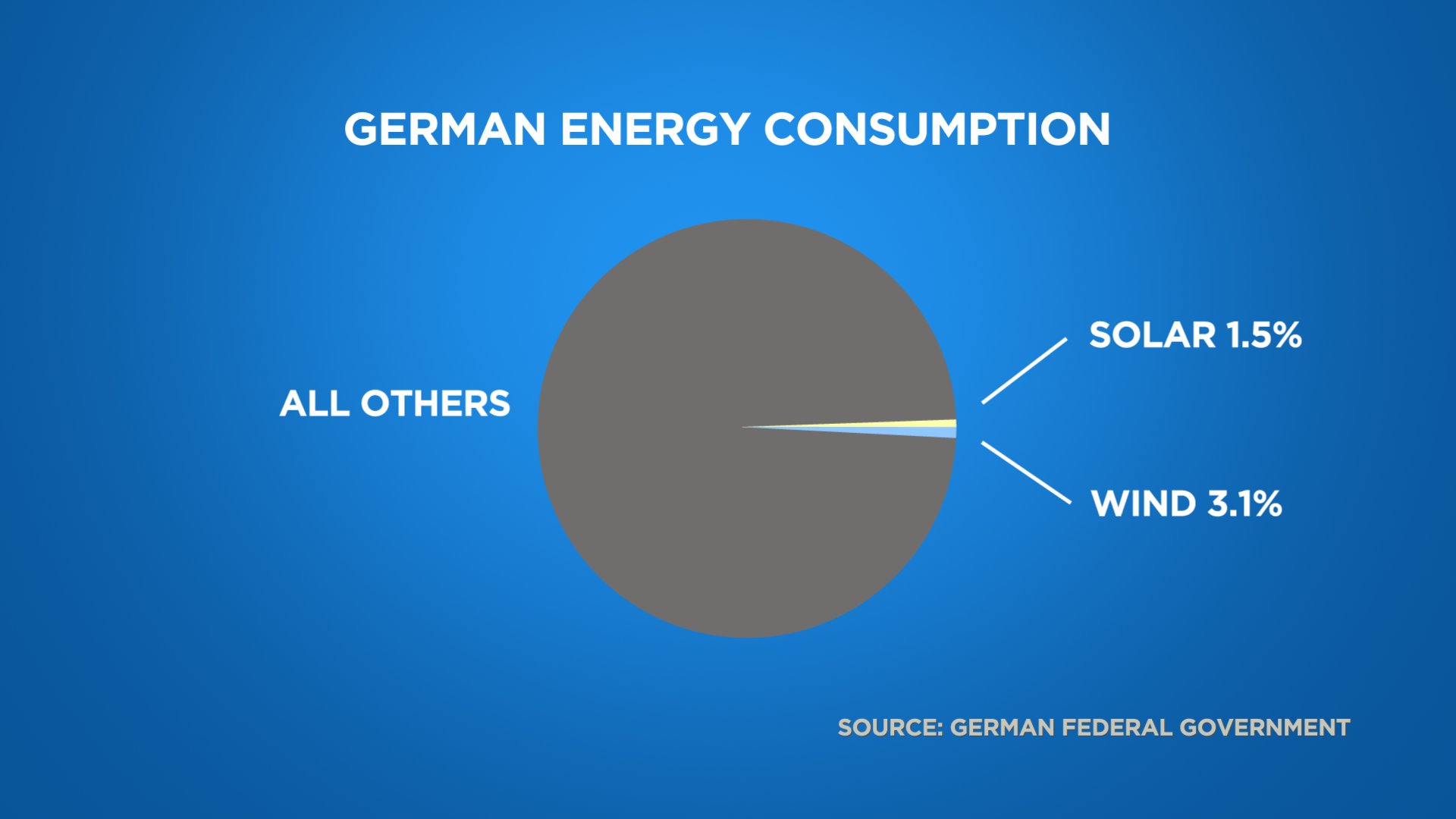
Source Data:
Total Energy: 12900 PJ
Total Solar PV: 46.2 Twh
Total Solar Thermal: 8.9 Twh
Total Wind: 111.6 Twh
Solar is 1.5% of total energy
Wind is 3.1% of total energy
Source: German Federal Government, Umweltbundesamt (UBA) auf Basis AGEE-Stat, February 2019.
See also:

00:36:08
Ozzie: “All of the mirrors that you see there are built buy the Koch brothers, Guardian Glass industries a company that they control.”
Guardian Industries:
https://www.kochind.com/companies/guardian-industries
00:36:15
Ozzie: “Koch carbon creates a lot of the inputs that are used to create the cement and the concrete and the steel… the plants that build polysilicon for solar cells. They have actually their own solar line called Solar Molex.”
Koch Industries, companies:
Koch Industries
00:39:18
Title Card: 500 year old yucca plant at Ivanpah.
USDA: Yucca schidigera: “About 50% of Mojave yucca clones were estimated at 500 or more years old…Few clones were younger than 200 years old.”
Fire Effects Information System (FEIS)
00:40:02
The Joshua tree depended on the giant mammals to reach up high and eat their seeds and thus disperse the Joshua tree. But now stranded in time and space, the Joshua tree awaits a new fate: to be sacrificed in the name of progress.
Joshua Tree Woodlands: A Tale of Sloths, Moths and the Trees that Need Them: “Sloths wandered upwards of 10 miles or more before depositing dung, moving trees across great distances. The seeds of Joshua trees are otherwise poorly adapted for dispersal: they are not sticky or otherwise equipped for hitchhiking, unable to be born by the wind, and are not encased in fruit likely to be attractive to many animals; in fact, it seems that the seeds are usually killed by the stomach acids of the animals that do still consume them.”
Natural History Journal
00:57:16
“It’s not green, it’s not renewable, it’s not carbon neutral, it’s not anything they claim it to be, yet, they got an eleven and a half million dollar grant because it’s classified as renewable.”
Congress Says Biomass Is Carbon-Neutral, but Scientists Disagree:
Scientific American
Department of Energy Recovery Act State Memos: L’Anse Warden Electric Company, LLC, in L’Anse received $11.7 million for a biomass project. U.S. Department Of Energy
01:03:49 “Global Renewable Energy” graphic
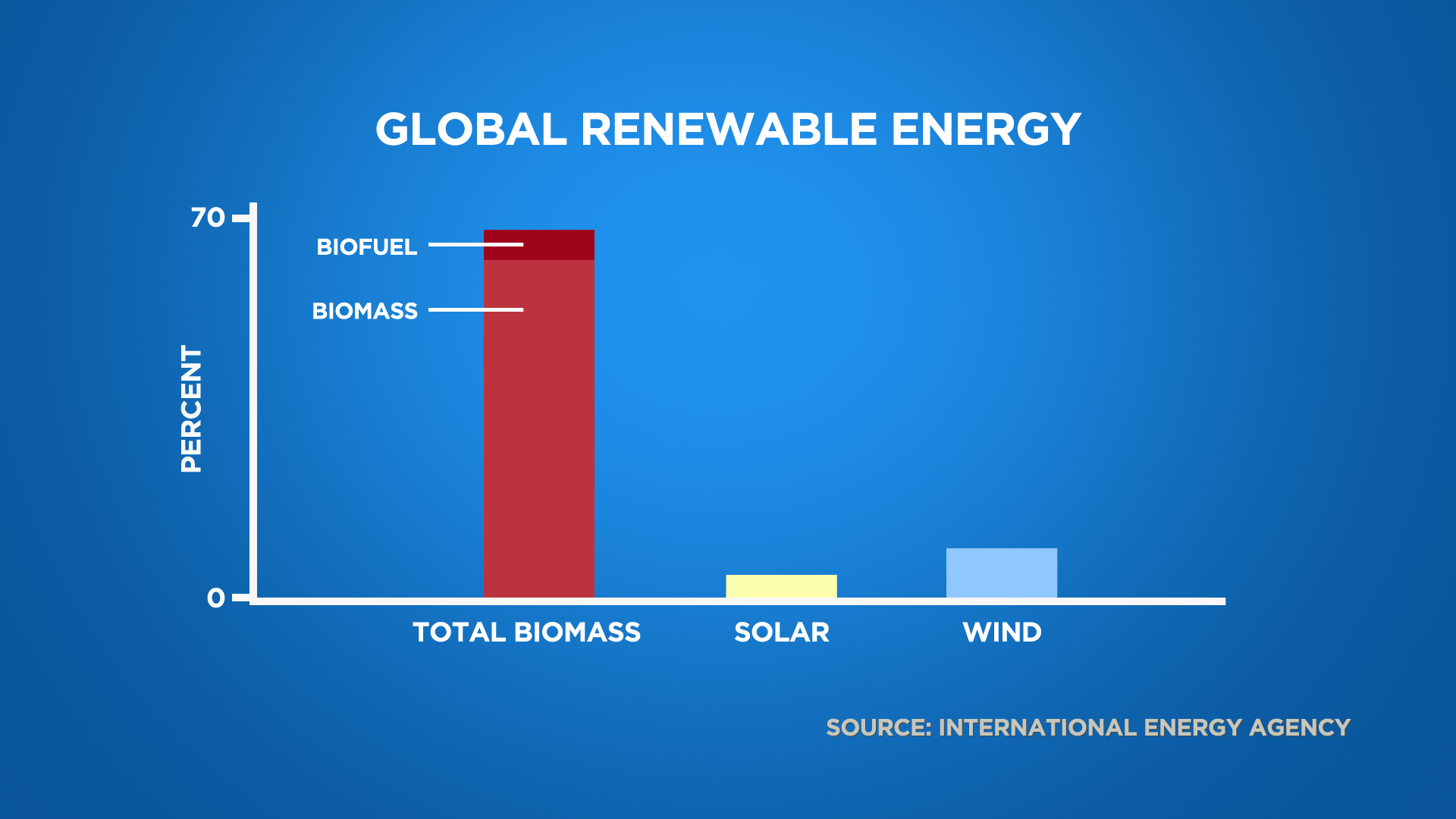
Source Data (expressed as percentage of what counts as renewable energy):
Total biomass: 1418 Mtoe (68%)
Wind/Solar: 289 Mtoe (13%)
comprised of:
– 1217 Twh Wind (9%)
– 570 Twh Solar (4%)
Other renewables: 19%
Source: International Energy Agency, Global energy demand and electricity generation by source, accessed March 2020. For more detail see: International Energy Agency
Abandoning the concept of renewable energy: “the loose 1970s-era definition of “renewable energy” and its positive associations have permitted politicians and lobbyists to get away with what are essentially bait-and-switch schemes that seem to address climate change, but in reality serve only to improve public image or promote selected technologies or interest groups and may hinder emission reductions or even increase them and cause other undesirable environmental impacts…bioenergy is perhaps the most problematic of all energy sources that are nevertheless widely considered renewable”
Elsevier: Energy Policy
Europe’s renewable energy policy is built on burning American trees: “Biomass energy is inadvertently making the climate crisis worse – As they steadily wean themselves off coal, European Union nations are banking on wood energy, or ‘biomass,’ to meet their obligations under the Paris climate agreement.”
Vox, supported by the Pulitzer Center
01:03:57 “Germany Renewable Energy” graphic
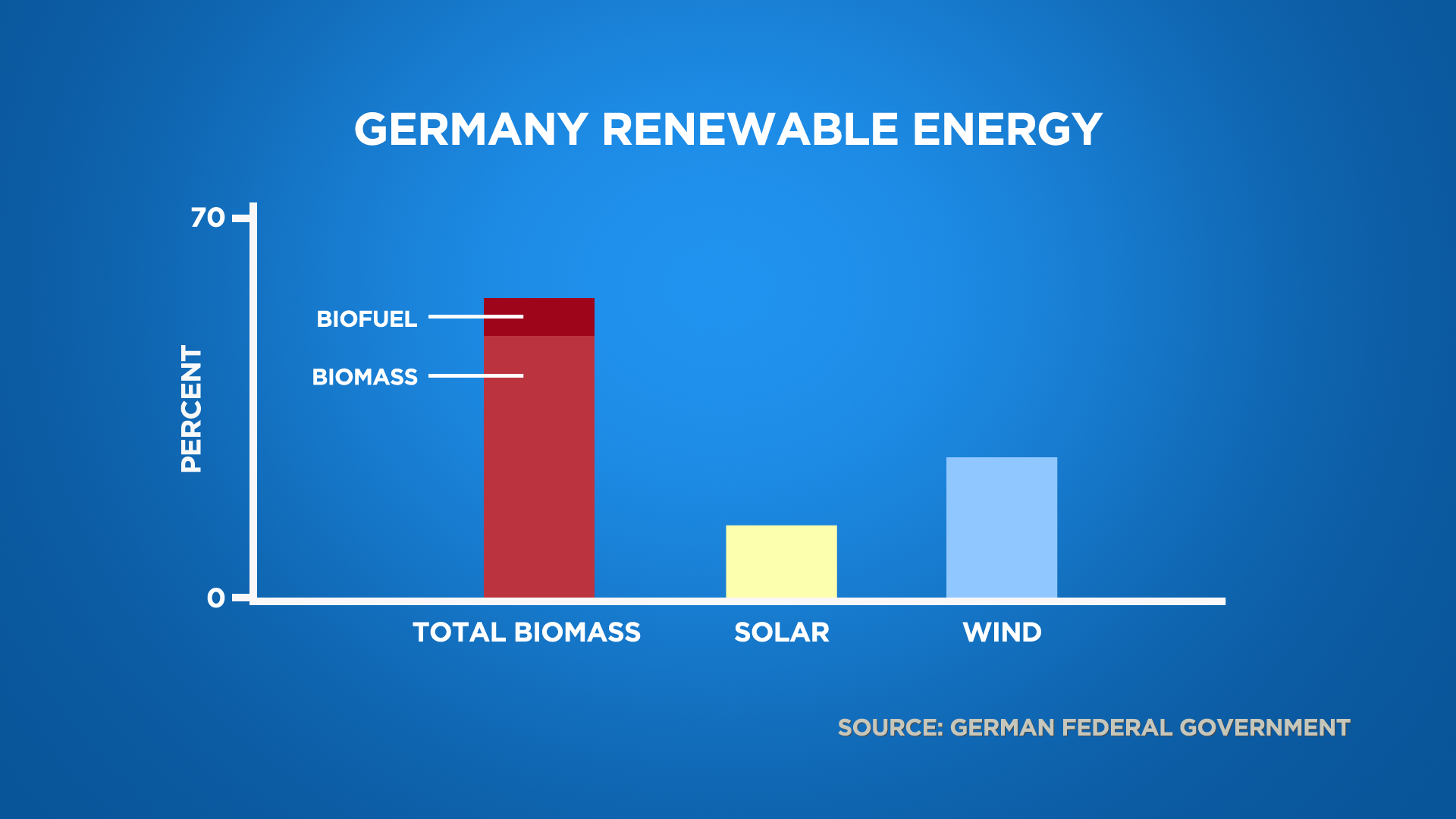 Source Data (expressed as percentage of what counts as renewable energy):
Source Data (expressed as percentage of what counts as renewable energy):
Biomass: 55% of total German renewable energy
Wind: 26% of total German renewable energy
Solar: 13% of total German renewable energy
Other: 6%
Source: German Federal Government, Umweltbundesamt (UBA) auf Basis AGEE-Stat, February 2019.
01:08:00
Topic: Bill McKibben’s support for biomass
Bill McKibben has indicated he came out against biomass in 2016. We were aware of Mr. McKibben’s 2016 op-ed presenting disadvantages of biomass. That op-ed also states that existing biomass plants should nevertheless remain in operation. These actions are an endorsement of the status quo, and do not meet Mr. McKibben’s own standards for action. As of this date, Mr. McKibben has not called for the biomass plant at Middlebury College, nor biomass plants in general to be closed. Mixed-messaging is a topic portrayed in the film.
After writing his 2016 op-ed, Mr. McKibben continued support for national legislation to fund new biofuel/biomass infrastructure. In 2017, he endorsed the 100 by ’50 Act, which included grants up to $100 million for “second-generation advanced biofuels,” which are defined as including wood chips and forestry “waste,” as well as the extension of biofuel producer credits, which the Koch Brothers had also lobbied for. Bill McKibben is still listed as a fellow at the institute that worked to create and promote the legislation. During this period after his 2016 op-ed, Mr. McKibben also supported a Sierra Club initiative called “Ready for 100,” which cited Burlington, Vermont, whose biomass plant is featured in the film, as an example of 100% renewable energy.
Mr. McKibben’s subsequent op-ed, which came out after the premiere of the film at the Traverse City Film Festival, is noted at the end of the film. See also our reply to Mr. McKibben.
01:11:17
…leading timber investment adviser.
Seeing the Forest for Its Hedges: “Jeremy Grantham, co-founder and chief investment strategist at GMO, the asset manager based in Boston, calls timber ‘a perfect investment’”
The New York Times
Timber Set to Soar Says Jeremy Grantham: “Jeremy Grantham, famous for co-founding the Grantham Mayo Van Otterloo (GMO), has made a series of forecasts that investors may want to pay attention to. Grantham has become a household investing name with his uncanny predictions of numerous asset bubbles as well as his general knowledge of the financial world. According to Mr. Grantham, the next seven years will see timber outperform all other asset classes.”
Insider Monkey
01:19:10
Here’s Al Gore … lobbying Congress on behalf of the sugar cane ethanol industry.
Global Climate Change: “Vice President Gore testified at a joint meeting of House committees about global climate change, environmental policy, and future policy options to reduce emissions and improve environmental standards. In his testimony he characterized the problem as the most dangerous crisis in American history and proposed several measures to fix the problem, such as an immediate freeze on new emissions from cars and power plants. Several lawmakers expressed doubts about the scientific evidence for his claims and feasibility of the solutions.”
C-Span
01:22:07
The New York Times partners with Exxon Mobile to bring you the good news about biofuels.
The future of energy? It may come from where you least expect it:
The New York Times
01:23:20
The Nature Conservancy is now the logging conservancy.
Forests as a Climate Solution? Yes, Naturally:
The Nature Conservancy
Further Reading:
Jason Hickel – Why Growth Can’t Be Green, New data proves you can support capitalism or the environment—but it’s hard to do both: “Many policymakers have responded by pushing for what has come to be called “green growth.” All we need to do, they argue, is invest in more efficient technology and introduce the right incentives, and we’ll be able to keep growing while simultaneously reducing our impact on the natural world, which is already at an unsustainable level. In technical terms, the goal is to achieve “absolute decoupling” of GDP from the total use of natural resources, according to the U.N. definition. It sounds like an elegant solution to an otherwise catastrophic problem. There’s just one hitch: New evidence suggests that green growth isn’t the panacea everyone has been hoping for. In fact, it isn’t even possible.”
Foreign Policy
Bill Rees – Don’t Call Me a Pessimist on Climate Change. I Am a Realist: “As long as the growth in demand exceeds additions to supply from renewables, the latter cannot displace fossil fuels even in electricity generation — and remember, electricity is still less than 20 per cent of total energy consumption, with the rest being supplied mostly by fossil fuels.”
The Tyee
Sean L. Maxwell, et al – Biodiversity: The ravages of guns, nets and bulldozers, The threats of old are still the dominant drivers of current species loss: “There is a growing tendency for media reports about threats to biodiversity to focus on climate change. Here we report an analysis of threat information gathered for more than 8,000 species. These data revealed a contrasting picture. We found that by far the biggest drivers of biodiversity decline are overexploitation (the harvesting of species from the wild at rates that cannot be compensated for by reproduction or regrowth) and agriculture (the production of food, fodder, fibre and fuel crops; livestock farming; aquaculture; and the cultivation of trees).”
Nature: International Weekly Journal Of Science
Jasper Bernes – Between the Devil and the Green New Deal: “To meet the demands of the Green New Deal, which proposes to convert the US economy to zero emissions, renewable power by 2030, there will be a lot more of these mines gouged into the crust of the earth. That’s because nearly every renewable energy source depends upon non-renewable and frequently hard-to-access minerals: solar panels use indium, turbines use neodymium, batteries use lithium, and all require kilotons of steel, tin, silver, and copper. The renewable-energy supply chain is a complicated hopscotch around the periodic table and around the world.”
Commune Magazine
Matt McGrath – Nature crisis: Humans ‘threaten 1m species with extinction’: “… while the Earth has always suffered from the actions of humans through history, over the past 50 years, these scratches have become deep scars. The world’s population has doubled since 1970, the global economy has grown four-fold, while international trade has increased 10 times over.”
BBC News
WWF – Living Planet Report 2018: “We are living through the Great Acceleration – a unique event in the 4.5 billion-year history of our planet – with exploding human population and economic growth driving unprecedented planetary change through the increased demand for energy, land and water.”
WWF
Christopher Ketcham – The Fallacy Of Endless Economic Growth: “Researchers at Monash University, marshaling considerable data, concluded that the cheerful scenarios projecting renewables will supply most of the world’s energy by mid-century “assume unrealistic technical potentials and implementation times.” Which means we’ll be stuck mostly with fossil fuels to keep the expansion machine running. Tim Jackson of the University of Surrey has calculated that, at current rates of carbon density—the amount of carbon released per unit of energy consumed—our greenhouse gas emissions will increase by more than 2 percent per year. At that rate, by 2050 carbon dioxide emissions would be more than double what they were in 2015…”
Pacific Standard Magazine
